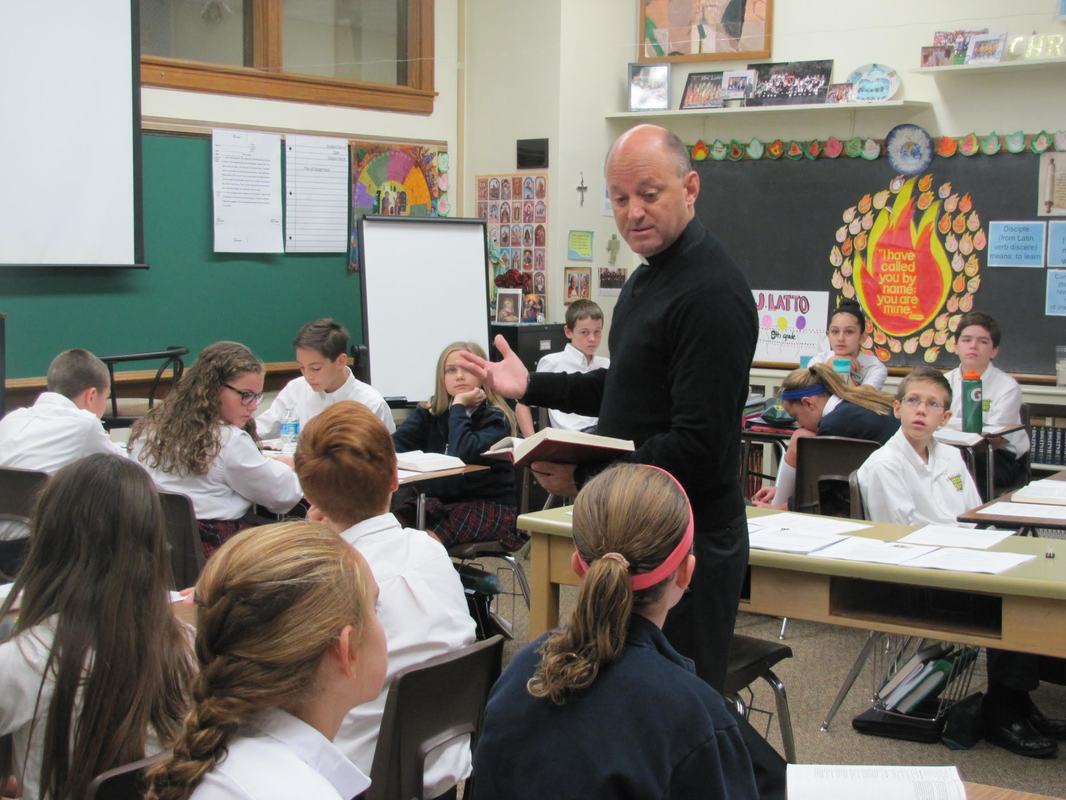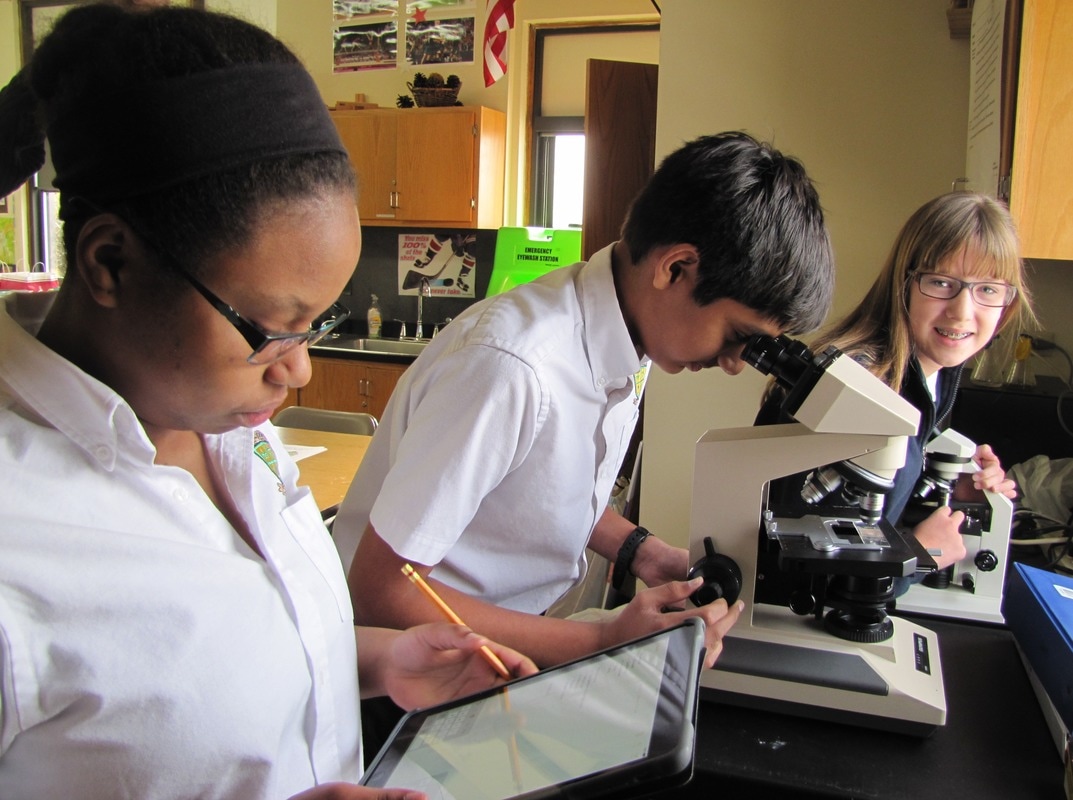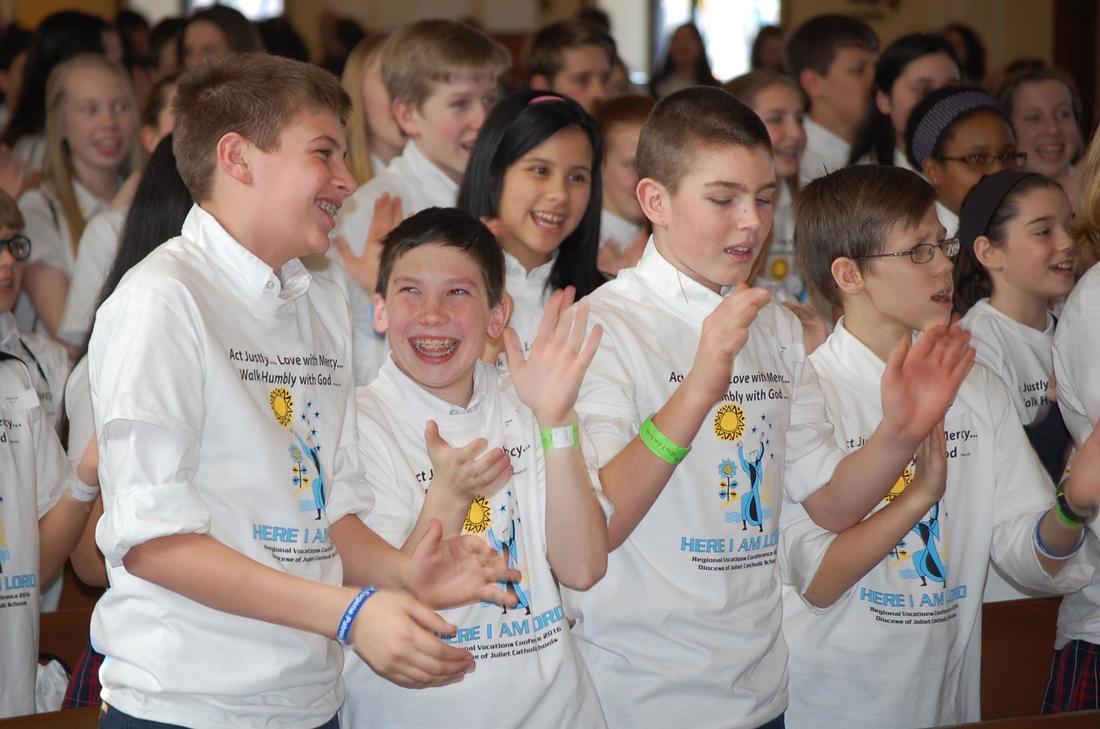8th Grade Curriculum
Religion
Students will:
- develop prayer life using Liturgy of the Hours;
- use Bible citations in all Religion work;
- participate in the planning and execution of the Mass and Devotional Events;
- develop skills in making moral choices and living a virtuous life with the guidance of the Holy Spirit;
- study major events of Church History;
- prepare for the Sacrament of Confirmation by participating in parish-wide activities;
- understand the daily journey to reach God by modeling the values of Jesus through service to others; and
- develop a further understanding of the Liturgical Year through Sunday Readings.
Language Arts
Our Language Arts program includes reading, writing, speaking, listening, study of grammar, and vocabulary.
Readings
- Reads and comprehends literary and informational texts independently and proficiently noting details, text structure, and integration of ideas.
- Researches topics using print and digital tools to locate, analyze, and evaluate information.
- Develops a lifelong love of reading through exposure to a wide variety of literature, nonfiction text, and self selected books.
- Attends a weekly library class with ample opportunity to select books and magazines to read for pleasure.
Writing, Language, Speaking and Listening
- Produces clear and coherent writing in which the development, organization, and style are appropriate to task, purpose, and audience.
- Demonstrates command of conventions of standard English grammar and usage when writing and speaking.
- Engages effectively in a range of collaborative discussions building on others’ ideas and clearly expressing their own.
- Acquires and uses vocabulary based on grade level reading, content, and study of Latin and Greek roots.
- Uses a variety of digital tools to produce and publish writing as appropriate.
Mathematics
Students will develop skills in:
- order of operations, powers and square roots:
- number line as a tool to model operations with positive and negative integers;
- multi-step equations;
- pictographs, bar graphs and line plots;
- irrational numbers and negative exponents;
- proportions and use percent to describe change in the real world;
- solving inequalities;
- unknown angle measures of polygons;
- algebra and geometry by graphing on the coordinate plane;
- geometric figures to find surface area and volume; and
- two variable linear equations.
Social Studies
Students will study United States History from the post-Reconstruction era (1870’s) to the present. Students will become actively involved in the study of history and geography through cooperative activities, writing in the discipline, analysis of primary documents, creation of alternative assessment products, and the integration of technology. A variety of interdisciplinary connections are planned. Historical eras to be studied include:
- The United States at the Turn of the Century;
- The Age of Imperialism;
- World War I;
- The Roaring ‘20s;
- The Great Depression and the New Deal;
- World War II;
- The Holocaust;
- The Cold War;
- American Culture: 1950s and 1960s;
- The Civil Rights Movement;
- The Vietnam War;
- Nixon’s Presidency/the United States in the 1970s;
- Key Issues/Events of the Late 20th Century; and
- The Illinois Constitution.
Science
Through the lens of Catholic Teaching, students will use a variety of sources including Problem and Research Based Learning to explore and master the Physical Science Next Generation Science Standards (NGSS) by the use of STEMscopes online resource, lab experiences and written reports, weekly STEM pre-engineering lessons, 1:1 technology, and higher level critical reading/ thinking activities. Concepts of focused study include:
- matter, physical/chemical properties and changes;
- Periodic Table, atoms;
- acids, bases, reactions;
- motion, forces, work and machines;
- waves, energy; and
- human responsibility to care for Earth.
- Participation in the Illinois Junior Science Academy Science Fairs.
Spanish
Students will continue to learn basic concepts of Spanish by reading, writing, listening and speaking. Concepts include a study of:
- the preterite verb tense;
- exploring Hispanic cultures;
- extending Spanish vocabulary;
- talking about present and past activities;
- affirmative and negative words; and
- giving opinions and describing preferences.
Physical Education
Physical fitness and well being will continue to be encouraged by focusing on refining movement and manipulative skills that encourage a lifelong appreciation for a healthy life style. Concepts include:
- participation in organized competitive, individual and team sports;
- officiating skills and team strategies;
- problem solving and cooperative skills with reinforcement through team challenges;
- handball;
- floor hockey;
- soccer;
- Frisbee activities; and
- softball.
Art
Students will be able to use all of the elements of design to create various art forms. They will demonstrate knowledge of art basics and take risks to achieve an art plan. Concepts include:
- drawing and painting in a variety of materials with direction towards animation and product design, advanced techniques in watercolor and Tempera paint;
- beginning visual literacy and looking at contemporary artists/designers that connect with technology and world issues;
- using art vocabulary to describe and critique their art work and the art work of others; and
- using iPads.
Music
Students will continue to participate in music activities and develop music appreciation. Concepts include a study of:
- identify musical forms;
- compose original pieces using the Garage Band app; and
- demonstrate knowledge of the basic principles of music.
Information Skills
Information skills include development of properly formatted bibliography for research projects; utilization of Hinsdale Library databases for in-depth research; and use of NewsELA, Worldbook Online and Britannica School to obtain information. Students plan and execute booktalks each semester to inform and persuade classmates about literature across genres. Students write to favorite authors and read books from the Caudill list. Students use NoveList and Destiny catalog to consult reviews and determine background information and read-alikes. Students continue to develop coding skills. During Poetry Month, various poets are studied in-depth, and various literary techniques such as allusion and onomatopoeia are considered. Students self-select books for checkout, developing strong independent reading habits.
Technology Skills
- Students create and innovate via the use of educational Apps in a 1:1 iPad to student environment.
- Using the Google Suite for Education (GSFE), students create documents, spreadsheets and presentations. They are introduced to Google add-ons which allow students to incorporate graphics and other multimedia tools into their documents.
- Students learn to collaborate through GSFE. This technology in our 1:1 environment teaches students group dynamics, encourages leadership and personal accountability.
- Online resources are used to support the research projects across all content areas. This includes World Book, Britannica School, Novelist, and Infoplease.
- Critical thinking and problem solving are supported via the use of STEMscopes and the STEM lab which meets once a week.
- Digital Citizenship includes lessons from Common Sense Media. These lessons focus on internet safety, cyberbullying & creating a positive digital footprint.
STEM
The Project Lead The Way Gateway Curriculum is an integrated approach to learning that provides cohesive, hands-on learning opportunities that access authentic real-world, applied learning experiences that empower our middle school students to gain the skills they need to thrive in high school and beyond. Our PLTW curriculum empowers our students to discover and explore interests, imagine and design solutions to real-world challenges, and become independent, confident problem solvers. Students apply knowledge and skills from a variety of disciplines that provides a solid foundation in STEM. The arts and STEM complement and balance each other with STEM representing the knowledge, tools, and processes to invent the future, and the arts providing us with our humanity. Essential art and design concepts blended into the PLTW curriculum to ensure a solid understanding of essential design concepts are scientific illustration, modeling, classic elements of design, videography, and photography. In the PLTW Design and Modeling unit, students discover the design process and develop and understanding of the influence of creativity and innovation in their lives. In the Automation and Robotics unit, students will learn about the history and impact of automation and robotics and they explore mechanical systems, energy transfer, machine automation, and computer control systems.
Elements of our Project Lead The Way curriculum include:
Elements of our Project Lead The Way curriculum include:
- an interdisciplinary approach to developing students’ understanding of STEM concepts and the Design Process;
- STEM lab;
- students will learn to think and solve problems as scientists, engineers, technologists, and mathematicians;.
- all students receive instruction that is aligned with the Next Generation Learning Goals and Standards;
- academic concepts are coupled with real world lessons;
- students apply science, technology, engineering, mathematics, and communication skills in context that make connections between school, community, work, and the global enterprise;
- problem-based, project-based, and inquiry based learning and collaborative decision-making;
- inquiry- rich content with scaffold inquiry activities;
- Engineering notebook documentation;
- cross-curricular connections that link reading, communication, and science in every activity;
- white boards used for instructions and presentations;
- iPads are used for research, communication, and learning activities;
- Desktop computers with monitors;
- PLTW online curriculum and resources for content area and reinforcement;
- three dimensional CAD software to enhance mathematics and engineering curricula; students will also use the CAD programs to investigate the art of design engineering;
- safe environment for students to experiment with new ideas;
- learning is measured through PLTW rubrics and assessments which use performance- based formative assessments and summative, content based specific assessments;
- students are expected to collaborate and work in partnerships, teams, and independently on a variety of PLTW activities and projects;
- STEM curriculum purpose is to increase student achievement and workforce readiness in STEM fields by engaging students in innovative science, technology, engineering, and math instruction;
- participation in extra-curricular activities expands learning opportunities in the STEM fields; and
- provide guest speakers who promote awareness and interest in diverse careers in science and engineering.
Resource and Speech/Language Pathology
St. Isaac Jogues School provides on site speech/language and resource services. Curriculum is child specific and designed to meet needs in reading, math and communication skills.





